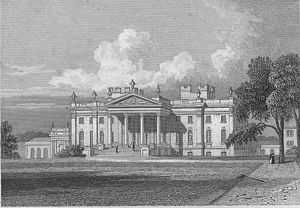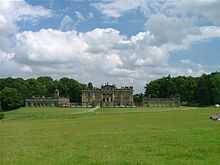Duncombe Park
 Duncombe Park circa 1829 | |
| Type | Stately Home |
|---|---|
| Proprietor | Baron Feversham |
| Managed by | Feversham Estate |
| Size | 182ha |
| Main feature | House |
| Other features | Parkland and gardens |
| Public access | Gardens only |
| Exhibition | Yes |
| Country | England |
| Region | Yorkshire and the Humber |
| UK Grid square | SE6082 |
| Address |
Duncombe Park, Helmsley, York, North Yorkshire |
| Postcode | YO62 5EB |
| Refreshments | Yes |
| Parking | Yes |
| Shop | Yes |
| Website | Website |
| 54°14′20″N 1°04′29″W / 54.23889°N 1.07472°WCoordinates: 54°14′20″N 1°04′29″W / 54.23889°N 1.07472°W | |
Duncombe Park is the seat of the Duncombe family whose senior member takes the title Baron Feversham. It is situated one mile south-west of Helmsley, North Yorkshire, England and stands in 300 acre of parkland. The estate has a commanding location above deeply incised meanders of the River Rye within the North York Moors National Park.

The house was completed 1713 for Thomas Duncombe (born Thomas Brown) to designs by the Yorkshire gentleman-architect William Wakefield.[1] It was remodelled in 1843 by Sir Charles Barry. In 1879 the main block was gutted by fire and remained a ruin until 1895 when rebuilding was carried out by William Young. The reconstruction was based on the original design, though there were changes made, especially in the interior layout to meet contemporary needs. It is of two storeys with a basement and attic.
The house itself is not open to the general public but visitors are allowed into the 30 acre garden from April until the end of August.
History
In 1694 Charles Duncombe, one of the richest commoners in England, bought the 40,000 acre Helmsley estate, occasionally staying at the castle. After his death in 1711 it passed to his sister Ursula and from her to her son Thomas Brown, who changed his name to Thomas Duncombe and commissioned the building of the present house. On his death in 1746 it passed to his son, Thomas Duncombe II, who extended the grounds to include the Rievaulx Terrace & Temples.[2] In 1774, Anne Duncombe, daughter of Thomas Duncombe of Duncombe Park was married to Robert Shafto, of Whitworth Hall, near Spennymoor, County Durham, the famous "Bonny Bobby Shaftoe" of the folk song.
In the late 1700s the estate was owned by Thomas' son, Charles Slingsby Duncombe, who was succeeded in 1803 by his eldest son and heir Charles. Charles was MP for Shaftesbury, Aldborough, Heytesbury and Newport IoW and High Sheriff of Yorkshire for 1790–91. He built up a considerable art collection at the house and was made 1st Baron Feversham in 1826.[3] His son William succeeded him and was MP for Yorkshire and after 1832 for the new North Riding constituency. William's son William Ernest was created the 1st Earl of Feversham. The second Earl was killed in the First World War and the earldom became extinct on the death of the third earl in 1963.
The building was used as a girls' school between 1914-1980. The Rievaulx Terrace and Temples were acquired by the National Trust in 1972. Since 1985 the house has been restored as a family home by the 6th Baron Feversham, but on his death in 2009 was left, not to his heir Jasper Duncombe, 7th Baron Feversham, but to a younger son Jake Duncombe.
The house closed to the public in 2011.[4]
In 2012, Duncombe Park was used in filming the period drama TV mini-series Parade's End as the fictional Groby Hall in Cleveland, North Yorkshire. The film stars Benedict Cumberbatch and Rebecca Hall and is based on the novels by Ford Madox Ford.
In March 2013 the International Centre for Birds of Prey opened a branch in the grounds.
Notes
- ↑ Died 1730; also credited with additions to Gilling Castle (Howard Colvin, A Biographical Dictionary of British Architects, 1600-1840, 3rd ed. 1995, s.v. "Wakefield William").
- ↑ "The History of Helmsley Walled Garden". Retrieved 2013-03-14.
- ↑ "DUNCOMBE, Thomas (?1724-79), of Duncombe Park, Yorks. and Barford Park, Wilts.". History of Parliament Online. Retrieved 2013-03-14.
- ↑ "Duncombe Park website". Retrieved 2014-01-17.
External links
| Wikimedia Commons has media related to Duncombe Park. |
- Map sources for Duncombe Park
- Duncombe Park National Nature Reserve